 Полная версия
Полная версияNature's Teachings

Thus, as the reader will see, we have in Nature an exact analogy of Art, the Termite queen being confined within her cell exactly as is the hen within the coop.
Being on the subject of eggs and egg-hatching, we will take another case in which Art has acknowledgedly followed Nature.
We all know that eggs are developed into life by means of well-regulated heat, and that with birds the general rule is, that the needful heat is supplied by the parent bird, who sits upon them for a certain time, until the young birds make their appearance in the world.
Under ordinary circumstances, the aid of the parent bird is quite sufficient; but when the progress of civilisation requires that the eggs of poultry should be hatched in numbers too great for the powers of the parent bird, Man has been fain to imitate Nature, and to invent machines whereby eggs can be hatched by artificial heat, regulated to the temperature of the hen’s body.
Various as are these machines in detail, they are all alike in principle, and the right-hand figure of the accompanying illustration will give a fair idea of the method which is employed.
A box is fitted up with trays, on which the eggs are arranged. At the bottom of the box there is the heat-producing apparatus, which can be regulated at pleasure. The trays of eggs can be moved from one part of the box to another, so as to insure the right amount of heat, and, if this process be only carefully carried out, the young chicks emerge from the eggs exactly as they would have done if the hen had sat upon them.
This machine is sometimes called the Artificial Mother, and it is worthy of notice that it is no modern invention, the ancient Egyptians having used it more than three thousand years ago.
With regard to Nature, it would have been simple enough to give one illustration of a bird sitting on her eggs, but I have preferred to select a different subject, as more relevant to the question of artificial heat.
There is an insect to which we have had several occasions of reference, namely, the Wurble-fly of the ox, scientifically known as Œstrus bovis.
The eggs of this insect are deposited in the skin of the ox, and are there hatched by the heat of the animal. In proportion as the larva grows, it raises lumps upon the skin, these being practically the roofs of the artificial home. There are several other species of the same genus, all of which have their eggs hatched by the heat of the animals on which they are placed. There are, for example, the common Bot-fly (Œstrus equi), whose eggs are hatched in the interior of the horse, and the Sheep-fly (Œstrus ovis), whose eggs are hatched in the head of the sheep. The common Snake leaves her eggs to be hatched in the artificial heat produced by decaying vegetable matter.
We now come to the preservation of provisions.
In the first place, we have the well-known “cache” of Northern America—i.e. a spot wherein provisions are hidden, and their locality only marked by signs intelligible to those for whose use they are intended. It is, perhaps, hardly necessary to mention that many creatures—such as the dog, the squirrel, and most of the crow tribe—are in the habit of concealing provisions for future use.

In those parts of the world, however, where the rights of hunters are acknowledged, any one who kills a deer, or other animal of chase, and is not able to carry off the entire body, can preserve it for his own use. He simply cuts it up in hunter fashion, and hangs the various portions to branches of trees, where they are out of the reach of wild beasts. Stores like these, such as are shown in the illustration, are always respected, and no hunter would dream of helping himself to the game which was killed and dressed by another.
Beasts of prey, however, cannot be expected to be so punctilious, and in consequence the hunters hang their meat to branches which cannot be reached.
In Nature we find many similar examples, one or two of which are given on the left hand of the illustration.
In the centre is seen a group of eggs of the Lace-wing Fly (Hemerobius), so called on account of the delicate, lace-like structure of its beautiful pale green wings.
When the female lays her eggs she always chooses a slight twig, and upon it deposits a little drop of a slimy consistence. She then draws out this drop into a thread, which hardens as it is brought into contact with the air. At the extreme end of the thread she places an egg, which is thus kept at some height above the ground, and defies the approach of inimical insects. The eggs, as well as the stalks, are perfectly white, and have so singular a resemblance to mosses, that for many years they were actually classed and figured as such.
These egg-groups are plentiful enough, if the observer only knows where to look for them. I have several of them in my collection, and have found that nearly every one who sees them for the first time takes them for mosses. I never myself saw the pretty insect lay its eggs, and for the description am indebted to Mr. A. G. Butler, of the British Museum, who has kept them and watched their habits.
The objects on either side of the Lace-wing Fly’s eggs are egg-groups of certain spiders, suspended by threads from branches.
A still more remarkable instance of unconscious imitation may be found in the two objects in the accompanying illustration. It is hardly necessary to say that the right-hand figure represents a portion of the arrangement by which a butcher hangs up his meat out of harm’s way until it is wanted.
The hooks in question are simply formed into a double curve, like the letter S, and can be slid along the horizontal bar without any danger of falling.
Now, in the common Sloth we have an exact prototype of the butcher’s hook. The Sloth passes the whole of its life in the remarkable attitude which is shown in the illustration. It lives among the branches—not on them, but under them—its claws being long and curved, just like a butcher’s hook. I have often watched the animal traversing the branches, and have been greatly struck with the accurately picturesque description of the late Mr. Waterton, who was the first to discover the real character of the Sloth.
It was he who found out that the previous ideas as to the Sloth’s mode of life were utterly erroneous, and that, instead of being a sort of bungle, the Sloth was as perfect in its way, and as well fitted for its mode of life, as the lion or tiger. He discovered that the animal always hung from the branches, as shown in the illustration. In fact, as Sydney Smith remarked in his witty review of “Waterton’s Wanderings,” the Sloth passes his whole life in suspense, “like a young clergyman distantly related to a bishop.”
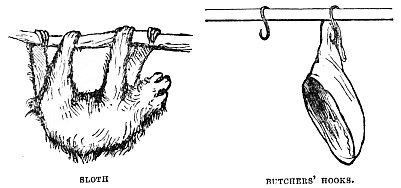
There are many other creatures which afford similar examples, though perhaps none are so striking as the Sloth.
For instance, there are the whole tribe of Bats, which, by means of the curved claws attached to their hind-feet, can hang themselves head downwards in the open air, and even swing in wind, without the least fear of falling.
CHAPTER VIII.
DOMESTIC COMFORT
How to make Home comfortable.—The Bed in its various Forms.—The Feather Bed of Man.—The Eider-duck and her Plumage.—The Rabbit and her Down.—The Long-tailed Titmouse and her wonderful Nest.—The Hammock of civilised Man and Savage.—The Sailor’s Canvas Hammock.—The String Hammock of tropical America.—Nest of the Pensile Oriole.—Silken Hammock of the Tiger-moth and other Insects.—The Mat Bed.—Cocoa-nut Matting.—The Robber-crab and its Bed.—Strength and Uses of the Cocoa-nut Fibre.—The Surgeon’s “Cradle” and the Pupa of Tabanus.—The Art of Sewing and the Tailor-bird.—Principle of the Umbrella and its Original Use.—Natural Umbrella on the Rosemary.—Servants and Slaves, and the Distinction between them.—The Use of Slaves in hot Countries.—Slavery in the Insect World.—The Ants and their Slaves.—Ornamental Gardening and Pleasure-grounds.—The Hanging Gardens of Babylon.—The Bower-birds and their Pleasure-grounds.
WE now come to a different branch of the same subject, namely, the means by which our dwellings are rendered comfortable.
After having procured a dwelling which can withstand the elements, we next look for a bed on which to repose, and which will ease the limbs and brain, wearied by the toils of the day.
Allusion has already been made to the ordinary feather bed and its multitudinous natural springs. We now have to see how the various kinds of beds are anticipated in Nature, and will begin with the feather bed.
As to our own beds, nothing need be said about objects so familiar, although, in order to preserve the parallelism, it is necessary to introduce an illustration on the right hand of the page.
On the left hand are shown two examples of natural feather beds, selected from many others on account of the exact parallels which they afford.
We all know the wonderful warmth and lightness of the Eider-down mattress or quilt, though there are comparatively few who know how the Eider-down is procured.
In common with many other creatures, the Eider-duck forms a bed for her young by plucking the down from her own body. Rabbits do exactly the same thing, as all boys know who have kept them, the only difference being that fur is substituted for feathers. So do many insects, stripping themselves of their own downy covering, and employing it for the comfort of their offspring.
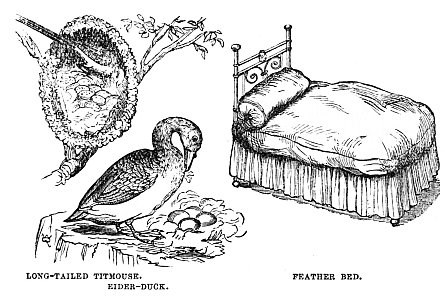
The lower figure on the left hand represents the Eider-duck in the act of plucking the far-famed down from her breast in order to make a soft and warm couch for her young, and the amount of feathers which she will devote to this purpose is simply astonishing. Their weight is insignificant, but their bulk is wonderful.
Above the Eider-duck is shown the nest of the common Long-tailed Titmouse. It is the most perfect nest that is constructed by any British bird. Its shape exactly resembles that of an egg, and it has but one small aperture, as is shown in the illustration.
The Titmouse lays a vast number of eggs, and almost fills the nest with soft downy feathers, on which they can rest. If the finger be introduced into the nest through the aperture, the tiny eggs can be felt reposing in their natural feather-bed. In this case, however, the bird does not denude herself of feathers, but has a way of picking them up wherever she can find them.
Now we will take another form of bed, namely, the Hammock, which is used in many parts of the world.
Putting aside the well-known hammock as used on board our ships, we will take the same kind of bed as used among the natives of tropical America.
In that wonderful part of the world, where water and vegetation reign supreme, an aërial couch of some kind is absolutely needful, and is supplied by the singularly ingenious hammocks which are constructed by the natives. They are made of a fine, but marvellously strong fibre, procured from the aloe plant by the simple process of soaking the long leaves in water, and dashing them against a stone. The soft green parts are eaten away, and the tough fibres remain in all their strength.
From these fibres are woven the strings of which the Hammocks are made. I possess four of the Hammocks, all made on different lines, but all based on the same principle. In some the strings are laid parallel to each other, and connected by transverse strings at regular intervals, but in the best specimens they are interlaced diagonally into a sort of loose network without knots, so that it yields in every direction to the outlines of the body.
It is one of the most comfortable couches ever invented, especially when it is of considerable size. I have one specimen which, even in its curved state, extends completely across a tolerably sized room. I never use it because it is so comfortable that the temptation to lie in it is almost too strong to be resisted.
As to Hammocks in Nature, they are almost too many to be computed.
So we will first take the nest of the Pensile Oriole, which is shown in the illustration, and which is an admirable example of the Hammock, being woven from long vegetable fibres intertwisted very much like the strings of the South American Hammock. And as if to increase the resemblance, the bird, whenever it can do so, will carry off hanks of cotton, linen, thread, or pieces of string, and weave them into its nest.
I have one of these nests, and, directly I saw it, was struck with its exact similitude to the Hammock of human manufacture.
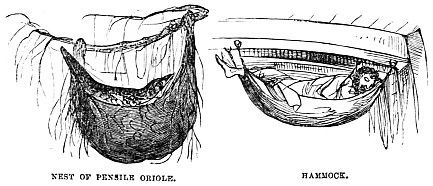
There are many other birds in various parts of the world especially in Australia, which make their nests on exactly the same principle, though in slightly varied forms.
Also, in the insect world, there are innumerable examples of the natural Hammock, the most common of which is that made by the caterpillars of the Tiger-moth, and in which it slings itself while undergoing its changes from the chrysalis to the perfect state.
It is made of silken threads, interwoven so slightly that the chrysalis can be seen through them, and so exactly like the Hammock of the South American Indian that if a drawing were made and enlarged, one might easily be taken for the other.
Now we come to the Mat Bed, which is so much used in the warmer parts of the world, where the earth is dry, and the air so warm that nothing is required but the slightest possible protection from the soil.
In inland places, such as Southern Africa, the bed is made of long grass-stems laid side by side, and sewn together with a sort of twine. One of these beds in my collection is some three feet wide by seven feet long, and can be rolled up into a cylinder so compact and light that even a child could carry it.
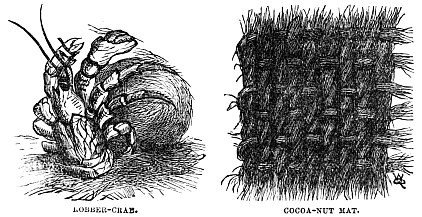
Of course, when the Kafirs are on a journey, the women have to carry the beds, together with the heavy wooden pillows and other necessaries, the men carrying nothing but their weapons. I have a pair of figures made by a native artist, representing a Kafir man and woman on a journey, the woman staggering under her heavy burdens, the bed being included, and the man stepping lightly along, with nothing but his spears and knobkerries.
On the sea-coasts, however, where the cocoa-nut palm grows, the fibre of the husk is the principal material for bedding. These fibres lie so parallel to each other on the surface of the cocoa-nut, that they are easily stripped off, fastened together, and formed into mats of any shape or thickness. One of these mats is shown on the right hand of the illustration, and the reader will see how simple is its manufacture.
Owing to the ease with which it is made into a fabric, the cocoa-nut fibre was in great use as armour before the bullet set all armour at defiance. It will be remembered that when Captain Cook was murdered, he committed the mistake of firing a charge of small shot instead of a bullet, and the fact that the cocoa-nut mat carried by the man at whom he fired resisted the shot, encouraged the natives to attack and murder him.
Even the cocoa-nut mat has its precursor in Nature.
There is a certain Crab inhabiting the cocoa-nut bearing parts of the world, which not only makes itself a bed from the fibre, but supplies it to mankind.
This wonderful Crab has the power of ascending the cocoa-nut palms, which is beyond the power of any man except a trained gymnast. It picks out the ripest fruits, and with its powerful claws tears off the fibre before breaking the shell and devouring the kernel, as is shown in the left-hand figure of the illustration.
After eating the kernel, which is at that time a soft, creamy substance, quite unlike the hard, indigestible material which we in England know by the name of cocoa-nut, the Crab carries off the external fibres into its den, and there makes its bed of them. So great, indeed, is the amount of cocoa-nut fibre thus collected that the natives are accustomed to save themselves the trouble of climbing the trees, and merely search for the holes in which these Crabs have made their nests, knowing the amount of ready-gathered cocoa-nut fibre that is always to be found in them.
Another modification of the bed needs a short notice, especially as I have practical and sad experience on the subject.

It is technically named the “cradle,” and is used to keep the bedclothes from pressing on a damaged limb.
When a mere lad I contrived, at cricket, to dislocate the right ankle, and break the bone. An ignorant surgeon refused my request for a cradle, and absolutely tied the cover of a book to the sole of the foot. Of course this appliance was worse than useless. It acted as a lever, allowing the clothes to turn the foot round, and to the present day the right foot has never recovered its faculties. Had the simple “cradle” been used—i.e. a few sticks bent into an arch-like shape, and tied together, so as to keep the clothes from even touching the foot—all would have been right.
On the right hand of the illustration is shown the surgical cradle, as a defence to a damaged leg. On the left is shown the curious natural cradle of the Gad-fly while undergoing its change into the perfect state. It is quite hard and rounded, being formed from the skin of the larva, and allows the pupa to lie within it, protected from any ordinary pressure.
Another point now comes before us.
We cannot well have our bedclothes—indeed, any kind of clothes—without the use of needles and thread. The simplest form of sewing is that which is adopted in many parts of the world, namely, of boring holes and pushing a thread through them, no eye being required in the needle. In this way the Kafirs of Southern Africa and the Esquimaux of the Polar regions make their beautiful garments of skins. I have for many years had in constant use two South African cloaks, or karosses, and one made by the natives of Vancouver’s Island, and they are now as good as they were when they were first given to me. Naturally, such a mode of sewing consumes much time, but, as time is not of the least value to these native furriers, no harm is done, and the junctions of the different skins is absolutely perfect. Even where holes have been made in the skin, the native furrier has supplied their places with circular pieces so neatly inserted, that on the outside not a trace of the junction is visible, and even the very set of the hairs is preserved.
Our very modern needles, with their eyes which carry the thread, are but a modification of the original plan of boring holes, and pushing the thread through them.
Nature has a singular parallel in the case of the Tailor-bird, which sews leaves together by their edges, and makes its nest inside them. It acts exactly like one of our own shoemakers, using its slender and sharply pointed beak in lieu of the awl, and employing a slight but strong vegetable fibre in place of the “waxed end” of the shoemaker, or the sinew-thread of the Kafir.
In the illustration an ordinary needle and thread are seen on the right-hand side, and on the left are two nests of the Tailor-bird, taken from specimens in the British Museum.
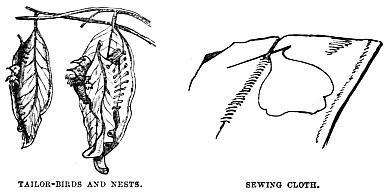
The mode of sewing is strangely like that which is employed by the uncivilised furriers who have been described, and much superior to that which is seen in many other parts of the world. For example, I have a West African quiver made of hide sewn together with stitches infinitely more clumsy than those of the Tailor-bird.
The reader will also remark that I might have placed this singular nest in the category of beds, on account of the soft and warm lining on which the young repose. I have, however, thought that it more properly belongs to the present division of the subject.
Sometimes we require a temporary as well as a permanent shelter from the elements, and procure it by means of the Umbrella.
In many countries, especially those where the climate is hot, the Umbrella is almost exclusively used, as, indeed, its name denotes, to preserve its owner from the direct sunbeams, and is, in fact, the “parasol” of our European ladies. It also is a mark of dignity, the amount and quality of its decorations indicating rank, even though the man who sits under its shade is clothed in a modest cotton cloth wrapped round his waist.
For the purpose of shielding the bearer from the sun the Umbrella was first introduced, and the introducer incurred the obloquy usual in such cases. Now, however, the Umbrella has by common consent become a defence against rain and snow, the male sex leaving the parasol to the gentler half of creation, and submitting themselves to the chance of a sunstroke.
We all know the ingenious Umbrellas of Africa, China, Japan, Siam, &c.; but there are few persons who know that a common magnifying-glass will disclose thousands of beautifully perfect umbrellas on the leaf of the Rosemary.
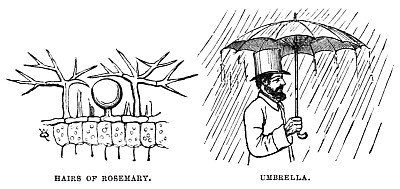
Pinch the Rosemary-leaf between the fingers, and a strong and peculiar perfume is evolved, just as when the peel of the orange is squeezed. The reason is the same in both cases, namely, the presence of multitudes of spherical vessels which contain their essential oil, secreted by the plant.
In the orange they are sunk below the surface of the skin, and are protected by it; but in the Rosemary they stand on slight footstalks, as shown in the illustration.
Being very delicate, and liable to be broken at the least touch, they are protected by a series of curiously formed hairs, which extend over them exactly as would an umbrella, and defend them from the elements.
The surface of a Rosemary-leaf affords a singularly beautiful sight, even with a common magnifying-glass, the tiny perfume-globes gleaming like little pearls in the broken lights that shine through the umbrella-like hairs.
Now we come to another part of domestic life, namely, Servants.
There is a diversity of ideas on this subject, as we know by the various discussions respecting “lady-helps” and “gentlemen-helps,” which bid fair to initiate a revolution in domestic life. Servants are sometimes called the greatest plagues in life, but it is difficult to see what could be done without them.
Then there is the complaint that servants are not what they used to be—the faithful retainers of the household, and considering themselves members of it. Perhaps not, but I have had experience of several faithful retainers, and invariably found them to be unmitigated tyrants, assuming power, repudiating responsibility, and being practically the master or mistress of the household.
Then we come to the great question of slavery in its various bearings.
Putting aside the now acknowledged diversity of races, and the well-known fact that the negro in a state of slavery to a European is infinitely better off than he would have been in his own country, where there is no law but that of might, we must entertain the question of enforced servitude, i.e. where the servants have no choice either in entering or leaving their situations.
It is, of course, opposed, and rightly, to our modern English ideas that a slave, under such a name, should exist on British ground. Yet there are thousands of Englishmen who are more wholly enslaved than was any negro in the worst times of slavery. The chains may not be of visible iron, nor the whips of tangible thongs, but they are, perhaps, all the more galling and biting.
Some of my readers may be aware that slavery exists in the insect world, and probably existed long before man came on earth.



